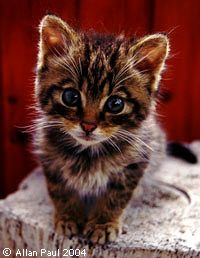Wildcat's sex life threatens it with extinction
By Allan Laign in the Herald, 26 th April 2004
 THE Scottish wildcat is on the brink of extinction, scientists warn today.
They say the species has interbred so extensively with the domestic cat that it is now critically endangered. THE Scottish wildcat is on the brink of extinction, scientists warn today.
They say the species has interbred so extensively with the domestic cat that it is now critically endangered.
In a report published today, Professor David Macdonald and Dr Fran Tattersall, of Oxford University's wildlife conservation
research unit, warn that the situation is so critical that the government must re-evaluate conservation measures Ð and the legal
protection afforded to the wildcat Ð if it is to be restored to the Scottish countryside.
Estimates of the population vary but it is generally believed that there are as few as 5000 roaming the hills and forests, mostly
in the Highlands and the north of Scotland.
This is not the first time the species has faced extinction. Before the first world war, the number of wildcats diminished
because of the efforts of gamekeepers. At one point, it was not to be found south of the Great Glen.
However, by the late 1940s the population had begun to increase once again and sightings spread to Angus, Moray, Argyll,
Perthshire, and Aberdeenshire.
Hybridisation with domestic cats has risen dramatically over the last few years. After a huge increase in the domestic
population, there are now reckoned to be 7.5 million household cats in the UK. A rise in human habitation, together with a
corresponding decrease in the wildcat's natural habitat, has meant that the pure wildcat has a much greater chance of meeting a
domestic cat.
Wildcats can easily interbreed with domestic cats because they are closely related in genetic terms. It is thought that most
couplings are between male wildcats and domestic females.
Today's report also suggests that the indigenous red squirrel now seems doomed to extinction in England and in southern
Scotland.
The findings reveal that circumstances "continue to worsen" for the species, despite every effort being made to save it from the
continuing invasion of grey squirrels and outbreaks of the parapox virus.
Earlier this year, conservation agencies and wildlife groups joined forces to announce a plan to protect the red squirrel in
Scotland. As one of the last areas in the UK where the grey squirrel has not yet taken control, the Highlands is regarded as the
last redoubt of the red squirrel.
Of the 160,000 that still remain, 120,000 are to be found in the Northern pine forests and conifer blocks. However, each year
the grey squirrel moves farther north.
The Oxford University report was commissioned by the Mammals Trust UK to investigate the state of the country's native
species.
On the positive side, the new research has established that, following their dramatic decline last century, otters are now found
to have returned to many parts of the UK as a result of extensive work by conservation organisations.
American mink numbers simultaneously have decreased and this is thought to be related to the revival of otter populations, as
these influence the foraging behaviour and, therefore, the diet of the mink.
The report also warns that the culling of badgers to prevent the spread of bovine TB may not be effective. Recent research
showed that there was a 27% increase in the number of cases in reactive culling areas compared with areas where no culling
took place.
The report goes on to say that herbicide-tolerant GM crops may be very damaging to biodiversity.
Last year, the results of the farm scale evaluations of three herbicide tolerant GM crops, maize, beet and spring oilseed rape,
were published. It found that there were more insects in and around the conventional beet and rape crops, as well as more
weeds and weed seeds. In the case of GM maize crops, where a different type of herbicide was used, there were found to be
more weeds, but not more insects.
Much of UK wildlife is dependent on invertebrates for food, including many mammals, such as wood mice, bats and
hedgehogs.
Caution and further research is recommended before the widespread introduction of GM crops.
Professor Macdonald said "This has been an extraordinary year for mammal conservation, with advances for creatures as
varied as water voles, otters and bats. However, there are also still huge problems ahead, such as the fate of the red squirrel
and Scottish wildcat.
"It is heartening to see that the public is becoming more and more enthusiastic and all the more so due to the activities of the
Mammals Trust UK."
© The Herald, 26 th April 2004
|





